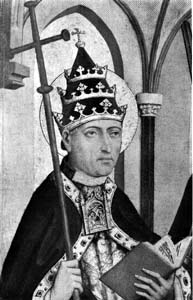Pope Gregory II
|
Pope Saint Gregory II |
|
|---|---|
 |
|
| Papacy began | 19 May 715 |
| Papacy ended | 11 February 731 |
| Predecessor | Constantine |
| Successor | Gregory III |
| Personal details | |
| Birth name | Gregorius Sabellus |
| Born | 669 Rome, Exarchate of Ravenna |
| Died | 11 February 731 Rome, Exarchate of Ravenna |
|
Papal styles of Pope Gregory II |
|
|---|---|
 |
|
| Reference style | His Holiness |
| Spoken style | Your Holiness |
| Religious style | Holy Father |
| Posthumous style | Saint |
Pope Gregory II (Latin: Gregorius II; 669 – 11 February 731) was Pope from 19 May 715 to his death in 731. His defiance of the Byzantine emperor Leo III the Isaurian as a result of the iconoclastic controversy in the Eastern Empire prepared the way for a long series of revolts, schisms and civil wars that eventually led to the establishment of the temporal power of the popes.
Born into a noble Roman family in the year 669, Gregory was the son of Marcellus and Honesta. As a young man, he was placed into the papal court, and was made a subdeacon and sacellarius (or treasurer) of the Roman See during the pontificate of Pope Sergius I (687 – 701). Later he was made a deacon and placed in charge of the Vatican Library.
During the pontificate of Pope Constantine Gregory was made a papal secretary, and accompanied him to Constantinople in 711 to deal with the issues raised by Rome’s rejection of the canons of the Quinisext Council. The actual negotiations on the contentious articles were handled by Gregory, with the result that the emperor Justinian II agreed that the Papacy could disregard whichever of the council’s decisions it wished to.
After Constantine’s death on 9 April 715, Gregory was elected pope, and was consecrated as Bishop of Rome on 19 May 715.
Almost immediately, Gregory began the task of repairing the Walls of Rome, beginning at the Porta Tiburtina. Work on this task was delayed in October 716 when the Tiber river burst its banks and flooded Rome, causing immense damage and only receding after eight days. Gregory ordered a number of litanies to be said to stem the floods, which spread over the Campus Martius and the so-called Plains of Nero, reaching the foot of the Capitoline Hill. The first year of his pontificate also saw a letter arrive from Patriarch John VI of Constantinople, who attempted to justify his support of Monothelitism, while at the same time seeking sympathy from the pope over the position he was in, with respect to the emperor. Gregory responded by sending a letter outlining the traditional Roman position against Monothelitism.
...
Wikipedia
